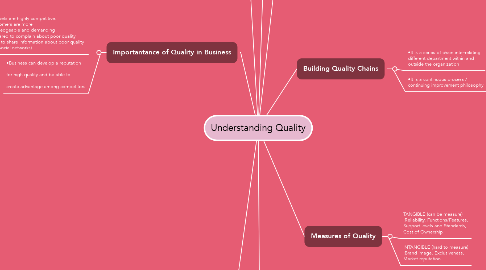Understanding Quality
by Ia Joyce

1. Customer Need & Expectations
1.1. Performance (Fit for Purpose)
1.2. Availability and Delivery
1.3. Reliability / Durability
1.4. Appearance
1.5. Price
2. Importantance of Quality in Business
2.1. •Markets are highly competitive: -Customers are more knowledgeable and demanding -Prepared to complain about poor quality -Able to share information about poor quality (thru social networks)
2.2. •Business can develop a reputation for high quality and be able to create advantage among competitors
3. Relationship Between Quality and Competitiveness
3.1. •Fewer business are competing solely on price
3.2. •At a similar price, the higher-quality product is likely to win
3.3. •Quality enables business to differentiate its product from the competition
4. What is Quality?
4.1. •It meets the needs and expectations of the customer to a product or service
4.2. •It is the most important competitor weapon
4.3. •CUSTOMER POV: Quality means fitness for use and meeting their requirements/expectations
4.4. •PROCESS POV: It means conformance with the process design, standards and specifications
4.5. •PRODUCT POV: It means degree of excellence of the product at an acceptable price
5. Benefits of Greater Quality
5.1. Customer Satisfaction
5.2. Repeat Purchase
5.3. Customer Recommendation
5.4. Lower Marketing Cost
5.5. Higher Customer Loyalty
6. Building Quality Chains
6.1. •It is a series of chain inter-relating different department within and outside the organization
6.2. •It is a continuous process / continuing improvement philosophy
7. Measures of Quality
7.1. TANGIBLE (can be measure) :Reliability, Functions/Features, Support levels and Standards, Cost of Ownership
7.2. INTANGIBLE (hard to measure) :Brand image, Exclusiveness, Market reputation
8. Quality Management Principles
8.1. •CUSTOMER FOCUS• Understand the needs of existing and future customers
8.2. •LEADERSHIP• Establish a vision and direction for the organization
8.3. •ENGAGEMENT OF PEOPLE• Ensure that people’s abilities are used and valued
8.4. •PROCESS APPROACH• Prioritize improvement opportunities and deploy resources effectively
8.5. •IMPROVEMENT• Improve organizational performance and capabilities
8.6. •EVIDENCE-BASED DECISION MAKING• Ensure the accessibility of accurate and reliable data
8.7. •RELATIONSHIP MANAGEMENT• Establish relationships considering both the short and long term


